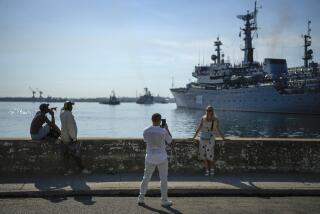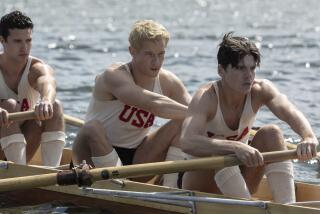Russians Finally Get Their High on the Seas : America’s Cup: Sailors didn’t get a chance to challenge, but they get a ride on the 12-meter America-II.
SAN DIEGO — Perhaps they would have described the experience as similar to going to Disneyland for the first time.
Except none of them--all adults, most with children of their own--have been to any Walt Disney playground.
“You should have seen them,” said Leslie McMillan, who arranged a day of sailing for Age of Russia crew earlier in the week. “They were like little kids in a candy store. Talk about wide-eyed. They were so excited. You could just see their faces light up.”
It provided a stark contrast to what the crew looked like when it arrived at Lindbergh Field Dec. 21, haggard from a 72-hour journey from their homeland.
“If we have one emotion about this day,” syndicate head Erik Grakovski said through an interpreter, “it is one of happiness.”
For four hours Wednesday, 14 Russian sailors did what they came to San Diego to do in the first place--sail. It wasn’t the America’s Cup, which was the original goal, but for at least one day, it was enough.
“Some of the crew have been out as individuals,” Grakovski said. “But this is the first time since we’ve been here that they’ve sailed as a group. We thank so much, Leslie.”
McMillan, president of McMillan Entertainment, provided Age of Russia their first collective sailing experience on America-II, the obsolete 12-meter yacht used most recently in the upcoming movie, “Wind.” Before that, the sloop sailed in the 1987 America’s Cup in Fremantle.
When McMillan heard that, like its boat, Age of Russia crewmen have spent most of their time in drydock, she figured they had been landlocked long enough.
“I couldn’t believe they had been here so long and hadn’t been out together,” she said. “I thought it was time someone take them out.”
Andrei Balashov, a former officer in the Soviet Navy who skippered the boat part of the day, said the adventure was an emotional boost for the crew.
“Their spirits were fairly high to start with, but this definitely raised them,” said Balashov, 45. “America-II, it was beautiful.”
According to Grakovski, most of the crew hadn’t sailed since mid-November, and for the better part of the morning, it showed.
Instead of functioning like the fine-tuned unit you expect in world-class sailing crews, the atmosphere aboard America-II, where Russians and five of the boat’s American crewman worked side-by-side, was one of mild chaos.
In all fairness, besides being a trifle rusty, the crew wasn’t familiar with this class of yacht.
“In the beginning, it was a bit hard because it’s been awhile,” Grakovski said.
In fact, McMillan planned a work party Friday, to repair one of the yacht’s broken hydraulic lines, which was damaged by the overzealous sailors.
No sooner had the yacht reached the dock, when the Russians asked when they might sail again. McMillan took them out again Saturday, Subway donated a box of sandwiches and a local merchant pitched in with some miniature Russian flags.
“They’re really starting to feel like they’re part of the community,” McMillan said.
Several crewmen said their social calanders are far from full, but they aren’t holed up like hermits either.
“To Red Onion, Sea World,” said Andrei Toptalov, 26, one of the youngest cremen, who is curious to see more of his host city. “Where would you like to take me?”
Crew members have taken language classes and pumped iron at Gold’s Gym, but there is no mistaking the syndicate’s purpose in coming to San Diego.
They never intended to be tourists. It was Age of Russia’s honest, if not naive, intent to sail in Russia’s first America’s Cup challenge.
“When we left, there was no doubt, and when we arrived, there still was no doubt we would sail (in the America’s Cup),” Grakovski said. “But so many things changed. When we left it was the Soviet Union, when we arrived it was Russia. So many things changed that were beyond our control.
“The financial and political collapse of our country stopped us from continuing.”
So did the ACOC-recognized challenger, Red Star ’92. When Red Star failed to get its yacht or crew to San Diego, Age of Russia hoped the Estonia-based syndicate would relinquish the challenge. But the battle between the two sides was so long and bitter, a compromise was out of the question.
Grakovski briefly addressed the problem of division within Age of Russia, quickly dismissing it as a small group looking out for its own best interests.
“There are some internal conflicts,” he said. “But always, when things break down, this happens. We’re trying to get on with sailing, while they’re trying to improve their livelihood.”
Russia’s widespread problems have left its citizens short everything from food and fuel, and has raised the obvious question: How can you think about a yacht race when your country is falling apart?
“Why do mountain climbers climb mountains,” Grakovski said. “Why do people go to sea in a storm; these are linked together. Sometimes you choose to live with a sport and you can’t do anything about the problems.”
But what does Age of Russia hope to accomplish by staying in San Diego with no chance of competing in the Cup?
“It is important for us to be here, so the (America’s Cup) community sees we are serious about this,” Balashov said. “We are disappointed, but this is a steppingstone toward other America’s Cups.”
Knight & Carver Yacht Center is working with Age of Russia to find sponsors so that the group can stay in San Diego through the races, maybe even stage its own exhibition regatta.
“We are working, trying to find sponsors,” Grakovski said. “We are looking for money, but it’s not to improve our quality of life, only so that we can sail.
“Because of the financial collapse, there are international communities working to help resolve some of the problems. We realize there are much more important problems than we have, so we are trying not to ask for more assistance.”
With reports that bread can cost up to a week’s salary in Russia, can anyone begin to afford a sport like sailing?
According to Nikolai Smirnoff, there are approximately 1,500 yacht clubs in Russia. Smirnoff said it is expensive, but most sailors don’t own yachts.
“Maybe up to six people go together and have one,” he said. “Or they have friends at yacht club and they’ll use someone else’s boat.”
Grakovski said the crew has found San Diegans friendly, and “not so unlike in appearance,” he said. And Russians and American might have something else in common.
“I tell you a secret,” he said with a laugh. “Hockey is more popular than sailing in Russia.”
Considering what they are likely to return to, are the crewmen eager to go home?
“We have a saying in Russia,” Balashov said. “It’s hard to translate, but it’s something like, ‘It’s nice to have new friends, but it’s nicer at home.’ ”
More to Read
Sign up for The Wild
We’ll help you find the best places to hike, bike and run, as well as the perfect silent spots for meditation and yoga.
You may occasionally receive promotional content from the Los Angeles Times.






